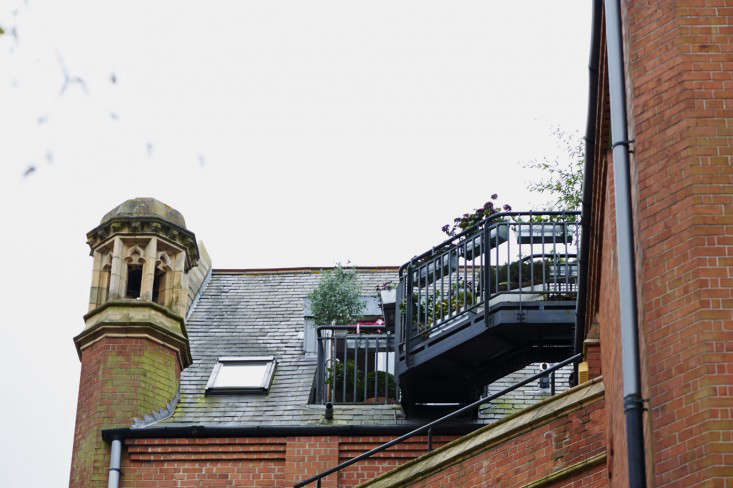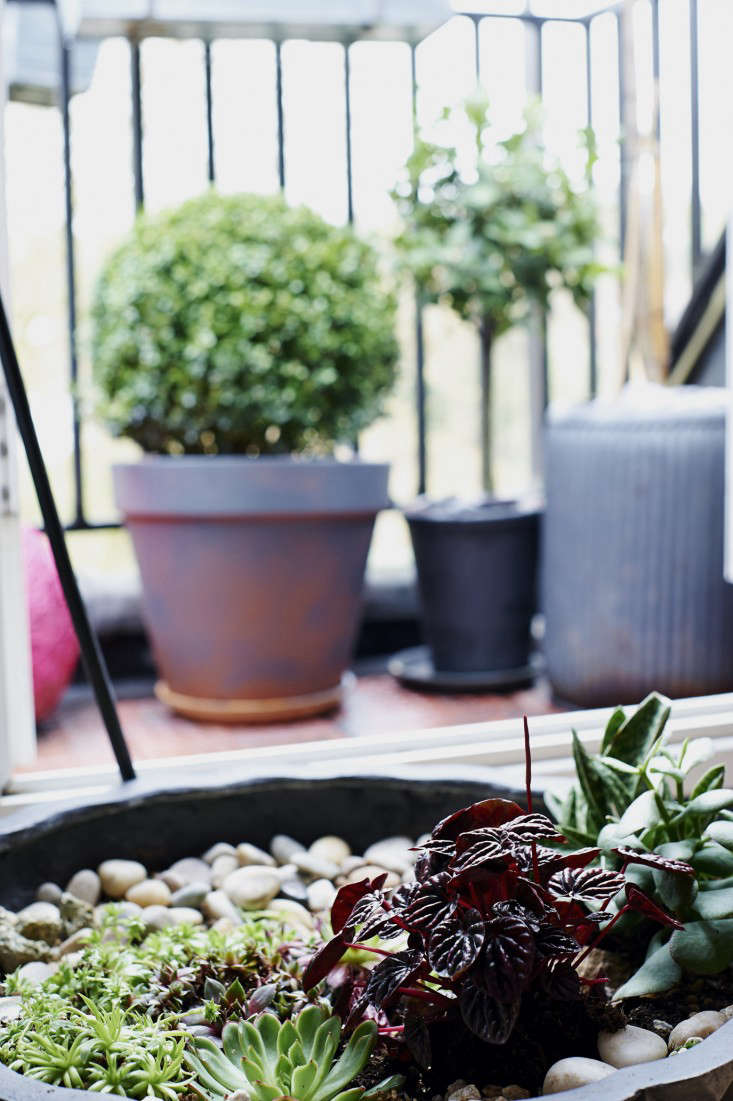For British garden writer and urban garden expert Isabelle Palmer, gardening is associated with happy childhood memories. “Growing up in rural Worcestershire, gardening was a pivotal activity in my family,” she says. “It’s what we did on the weekends.” After moving to London for art school and working in public relations for six years, her green thumbs became restless and she began seeking some–any–outdoor space to satisfy her yearning to grow things.
Luckily for Palmer, two balconies at her flat in a converted Congregational church proved the perfect place for a green space of her own. After establishing her city gardens, Palmer launched an online shop selling covetable pre-planted window boxes and gardening equipment; The Balcony Gardener business was born. Now the author of two books, The Balcony Gardener and the recently published The House Gardener, Isabelle Palmer has become the go-to expert on transforming small garden spaces on this side of the Atlantic.
On a recent visit to her balcony garden, she shared her top ten tips for transforming an empty balcony into a flourishing garden.
Photographs by Jonathan Gooch for Gardenista.

Above: Palmer’s flat is on the top two floors of a converted Congregational Church with a balcony on each floor. Here, her upper balcony as seen from the street.
1. Think of your balcony as an extension of your indoor space.
A balcony has the greatest impact as an extension of indoor space, and it’s important to ask yourself how you will want to use your balcony in relation to your indoor space. For small balconies, the goal is to bring the outdoors in. For those with larger balconies, it might mean a place to sit to enjoy some time in the sun with a cup of coffee and a book. Small spaces require you to think creatively and efficiently, and it’s prudent to have a clear idea of what you want before you start.
2. Build up your confidence by starting small.
Gardening is a long-term proposition and a balcony garden is no different. Don’t undermine your intentions by starting too big as too many plants and the maintenance required can overwhelm a new gardener. Instead, start with a few plants that require minimal upkeep. As you add more, build on your knowledge by documenting your failures, which will in turn give you the confidence to try more.

Above: The perception of greenery beyond any room makes an impactful connection with the outoors and will make your indoor space seem larger. Even if you only have a tiny balcony, it is worth the effort to put something green out there as it provides a focal point beyond the boundaries of your walls. Palmer likes to continue her color scheme, which she changes annually, from inside to outside. This year a dark gray wall is reflected in the color of her containers and offset with strong pinks of the hydrangeas in the window box.
3. Always keep a base of evergreens.
This will give you color all year round, even in the deepest winter months.
4. Use seasonal additions for variety.
Palmer introduces seasonal additions through a mixture of seeds and bulbs. “There’s nothing wrong with ready-made either for some instant gratification,” she says.

Above: Evergreens including boxwood, eucalyptus, thyme, and a bay tree hold down the fort for this season’s additions, hydrangeas, pansies, violas, and a sprinkling of oxalis.
5. Use no more than three colors, with green as a given.
Palmer recommends using no more than three colors to keep a small space from looking too busy. She likes to formulate her palette by either using different tones or shades of one color or using complementary and contrasting colors.

Above: Differing tones of pinks and purples from hydrangeas and oxalis create this season’s color palette.

Above: A tall bamboo screens the neighboring roof. White ranunculus plants have been placed at the far end of the balcony to draw the eye to the farthest point as a way to increase the sense of depth and make the balcony seem bigger.
6. Keep within the same color range for pots and containers.
To avoid having your plants upstaged by pots and containers, keep the base view calm by sticking within one color range.
7. Use a top dressing in your containers.
Top dressings such as pebbles, slate pieces, wood bark chips, or agricultural grit (for fruit and vegetables) will add a finishing touch while also unifying containers aesthetically. The soil in a container dries out quickly, and a top dressing will prevent water from evaporating too quickly. For more ways to save water in the garden, see Ask the Expert: Seven Ways to Save Water from a Graywater Crusader.

Above: Palmer uses white pebbles as a top dressing while the green plants in the background take visual precedence over her gray-toned containers. Palmer typically spray paints her pots to achieve the color she is after. In Paint it White: The World’s Easiest DIY Project, terra cotta pots are painted white with a matte exterior paint.

Above: With her training in art school, Palmer applies a painterly approach to mixing colors in her window boxes. Purple Prince hydrangeas fill a box that hangs from the balcony rail.
8. Check the load bearing capacity of your balcony.
It’s always wise to have a structural engineer check how much weight your balcony can support. Bear in mind that the weakest point of any balcony will be in the middle; keep the heavy pots around the perimeter.
9. The bigger the better for containers.
After you ascertain your balcony can sustain heavy loads, Palmer’s rule of thumb for containers is to go as big as will fit. Bigger containers hold more soil, which means there is less stress on the plant, giving it an optimal chance for healthy growth. “Aesthetically, the proportions of bigger pots look better as well,” she says.
Above: On her lower small triangular-shaped balcony, Palmer squeezes in a small foldable Fermob Bistro Table and Fermob Bistro Chair for her morning coffee.
10. Make your garden low maintenance.
After you’ve installed and planted your balcony garden, any time you can save on maintenance means more time to sit back, relax, and enjoy it. Some time-saving watering tips include:
- Using a hose pipe to water will be faster than using a watering can.
- When added to the soil, water saving granules will increase its ability to absorb water, thus reducing the need to water.
- A water ball or plant minder holds a reservoir of water that slowly seeps into the soil and only needs to be refilled about once every two weeks.
- An entry level drip irrigation system is something to consider if you are investing for the long term. See Hardscaping 101: Drip Irrigation to learn more.

Above: Hellebores and pansies planted in galvanized zinc window boxes sit on a narrow stone ledge.

Above: Palmer’s kitchen herb garden includes mint, chives, rosemary, beetroot, oregano, and parsley.

Above: A pot of barely discernible sweet peas sits on top of artificial grass that Palmer laid on her small balcony for added color. See Hardscaping 101: Artificial Grass for the ins and outs of using this material in your garden.

Above: Palmer grows an olive tree and strawberries in a window box.

Above: Isabelle Palmer enjoys some time tending plants on her balcony. For more advice on gardening in small spaces, her books The Balcony Gardener and The House Gardener abound with ideas.
See more of our 10 Tips for all things gardening: 10 Tips for the Beginning Gardener and Sarah Raven’s 10 Tips for Growing a Kitchen Garden and 10 Secrets for Growing an Urban Balcony Garden. On Remodelista, see what our resident color expert Eve Ashcraft has to say about The Power of Pink.












Have a Question or Comment About This Post?
Join the conversation